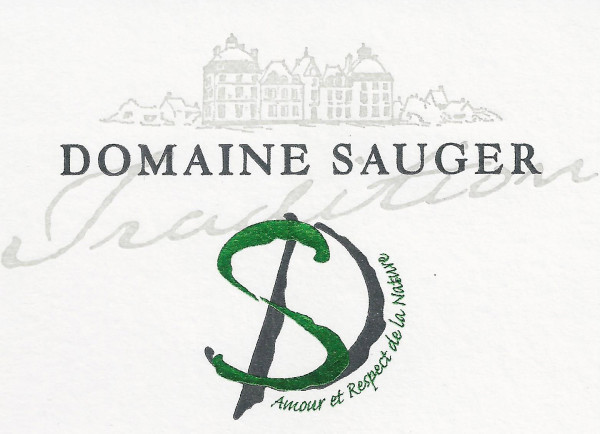
The Estate
Domaine Sauger has been family owned for 5 generations: From François-Sylvain, to Eugène, Lucien, Marcel, and now finally Philippe, the family has managed the winery since 1870.
In 1920, the grandfather Lucien operated 4 hectares of hybrid variety vines. The sale of the wine was done by a local négociant.
In 1958, Marcel, Philippe’s father, was forced to pull his hybrid vines due to phylloxera. Then in 1972, 4 hectares of vines were entirely replanted with noble varietals, such as Sauvignon.
In 1988, after receiving his BEPA in Viticulture-Oenology, and full of knowledge and experience after his internships in Gers and Sancerre, Philippe took the reins of the family estate and abandoned all other agriculture (asparagus, pickles ..) except for grapes, after which the domaine had 7 hectares to use for vineyards.
Philippe’s interest is focused exclusively on the vine, all while developing the vine nursery to the requirements of today. Modification of the production system and winemaking ensued: modernization of equipment, acquisition of a temperature controlled tank system … all this has led to a range of more rich and complex wines.
Today, Domaine Sauger is spread out over 30 hectares within the Appellation Contrôlée of Cheverny.
Location
Domaine Sauger is situated on the left bank of the Loire Valley, at the heart of Loir-et-Cher and the Chateaux of the Loire, such as Cheverny, Chambord, Blois, as well as Chenonceau. It is also bordered by La Sologne, a natural forest paradise.
Climate
Oceanic climate, tempered by the summer, and influenced by the grand forests of Sologne (national forests of Chambord, Cheverny, and Foret de Russy)
Soil
Sandy clay
Appellation
The Controlled Appellation of Cheverny is a relatively recent appellation; it was officially recognized by decree on March 26th, 1993.
It covers an area of 574 hectares within 24 districts situated in the Loire Valley, where about 40 winemakers produce nearly 27,000 hectoliters of wine per year.
Located between Loire and Sologne, the appellation of Cheverny is strongly marked by the movements of the Loire River, and the geology of the appellation is quite original compared to other appellations in the Valley: the soils there are predominantly of a sandy texture.
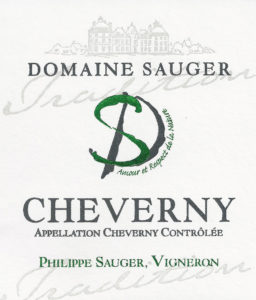
Cheverny Blanc Tradition
Grape Varieties: 80% Sauvignon Blanc, 20% Chardonnay
Harvest: Mechanically done at optimal maturity. Sorting on the vine and in the wine cellar.
Average Yield: 60 hl/ha
Vinification: Each grape variety in the blend is vinified separately, with slightly different maceration and remontages lasting between 8-12 days at 28°C. Racking, gentle pressing, and malolactic fermentation at 18-20 °C.
Aging: In stainless steel tanks for 4-6 months to ensure optimum fruitiness.
Tasting Notes: This wine is the result of a happy marriage between the Sauvignon grapes that perfectly express the soil and the Chardonnay grapes which lend a certain elegance. Brilliant pale color with silvery green reflections which develops aromas of citrus in the bouquet.
Food Pairings: Sea food, shellfish, asparagus.
Serving Temperature: 8-10°C
Cellaring Potential: 2-3 years
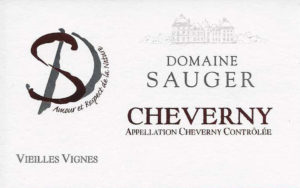
Cheverny Rouge Vieilles Vignes
Soil: Sandy clay
Climate: Oceanic with a temperate summer
Grape Varieties: Pinot Noir, Gamay, Côt (Malbec)
Harvest: Manual
Vinification: Fermentation in temperature-controlled vats for 12-20 days, remontage 1-2 times per day.
Aging: 50% of volume in barriques (1-5 years old) for 12 months, remainder in tank.
Yield: 40 hl/ha
Tasting Notes: This wine is a blend of the fresh and easy going Gamay grape and the slightly more dominant Pinot Noir. Beautiful, vibrant red color with aromas of red fruit, such as Morello cherries.
Food Pairings: Red meat, wild game, aged cheeses.
Serving Suggestion: Serve at room temperature, between 16-18°C. To be consumed within 5 years.
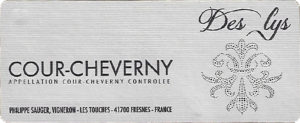
Cour-Cheverny Des Lys
Overview: Situated at the heart of France in Sologne, only a few kilometers from the greatest Chateaux in the Loire Valley such as Chambord, Cheverny, Blois, and Chenonceau, Domaine Sauger has passed from father to son for 5 generations, beginning in 1870.
Appellation: Cour-Cheverny
Grape Varieties: 100% Romorantin (local variety)
Yield: 50 Hl/Ha
Soil: Sandy clay
Climate: Oceanic with temperate summers
Harvest: Grape variety with late maturity. Manual harvest at the optimum ripeness.
Vinification: Direct pressing of the grapes with light skin maceration and temperature control to extract maximum fruit and aromas. Vinification in temperature-controlled stainless steel vats.
Tasting Notes: Romorantin expresses itself perfectly on this terroir and produces an exceptional wine with complex aromas of honey and acacia. This is a dry yet lively white wine. Subtle with good length on the finish.
Food Pairings: In its youth, this wine will accompany asparagus, fish, scallops and white meat. After a few years of aging, it will pair well with grilled poultry, lobster, or a nice slice of pan-fried foie gras.
Serving Suggestion: Serve between 8-12°C
Cellaring: 10-15 years
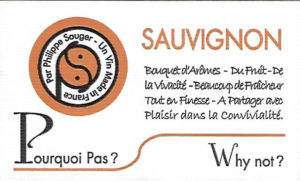
Sauvignon Blanc Pourquoi Pas?
Overview: Situated only a few kilometers from the most famous Loire Châteaux like Cheverny, Chambord, and Chenonceau, the Sauger vineyards have produced wine for generations, since 1870. They border the Sologne.
Grape Varieties: 100% Sauvignon Blanc
Yield: 90 hl/ha
Soil: Sandy clay
Climate: Oceanic with a temperate summer
Harvest: Mechanical
Vinification: Grape harvest with optimal maturity (analysis and tasting of grapes). Sorting, stemming, and direct pressing of the grapes for the most part. Maceration with skins (20-25%), static or cold settling for 12 to 24 hours. Slow fermentation at 18°C for 3 weeks in thermoregulated stainless steel tanks. No malolactic fermentation. Racking after fermentation is complete, then aging on the fine lees up until bottling.
Tasting Notes: Notes of citrus and exotic fruits in the bouquet. Fruity, fresh, and well-balanced on the palate.
Food Pairings: Seafoods, fish, shells, asparaguses, snails, or in aperitif.
Serving Suggestion: To be served between 8 and 10 degrees.
Cellaring: To drink in two years.


